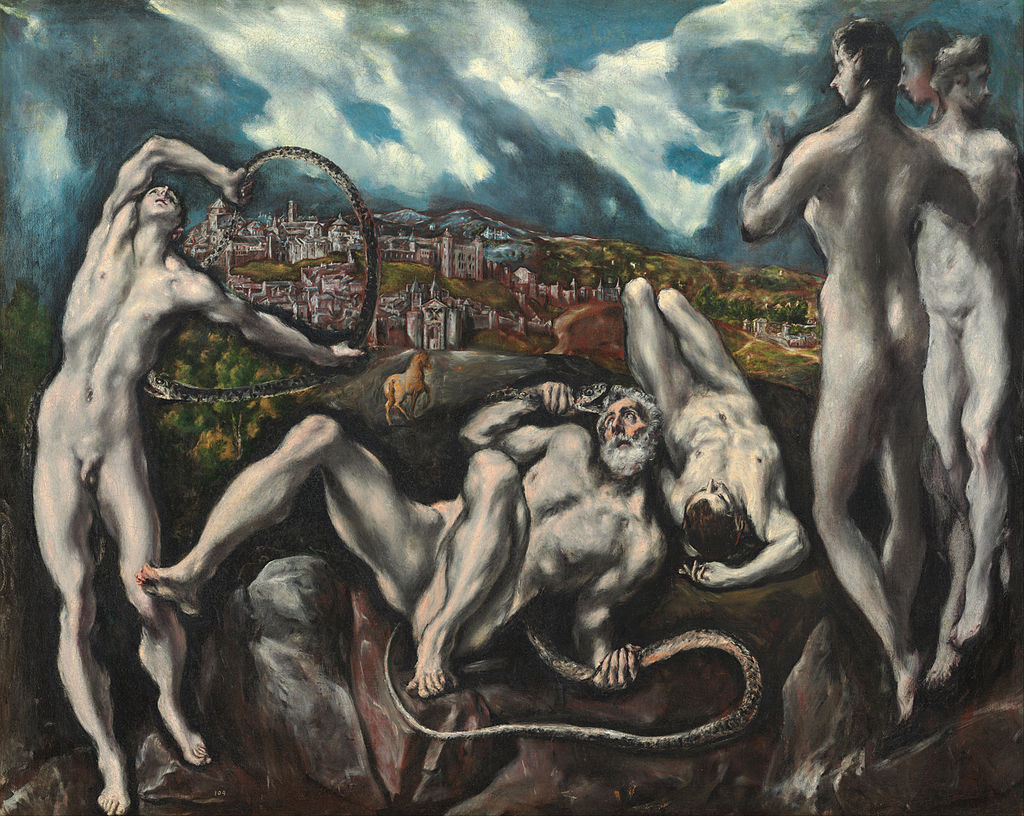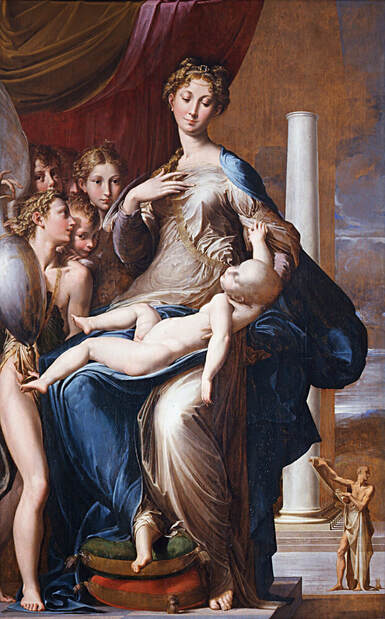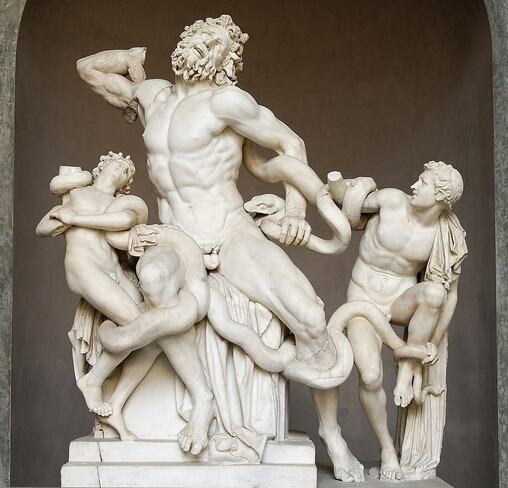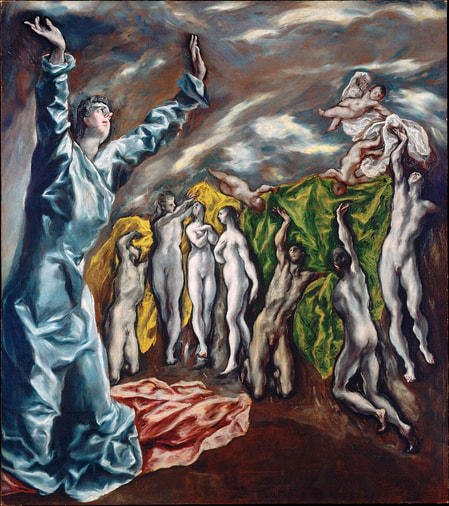|
Where? Gallery 28 of the National Gallery of Art
When? Between 1610 and 1614 What do you see? Laocoön is the bearded man lying down on the dark rocks in the center foreground. He is attacked by a sea serpent (a type of dragon in mythology). He grabs the serpent with both hands, but, nevertheless, the serpent bites him in the head. This serpent has already killed Laocoön’s son who lies to the right of him. On the left side stands the other son of Laocoön. He also struggles to fend off a serpent while the serpent is about to bite him in his abdomen. The three people on the right are unidentified witnesses to the killing of Laocoön and his two sons, though one of them looks away from the scene. They may represent Greek gods who were behind the punishment of Laocoön and his sons, but this is uncertain. The horse behind Laocoön represents the Trojan horse. The horse is on the way to Toledo, the fortified city in the background depicted under a gloomy sky. The entrance gate to the city is directly behind the horse. It is called the Puerta de Bisagra Nueva and still exists. This gate is decorated with a double-headed eagle.
Symbolism: This painting probably contains a deeper meaning. El Greco painted the scene of Laocoön and his sons in front of Toledo, the city where he lived and the former capital of Spain. He painted Toledo instead of Troy, which is the city where the horse is sent according to Greek mythology.
The killing of Laocoön and his sons in this painting takes place on a hill just outside Toledo. This would be the same place where prisoners and people who did not agree with the Catholic Church were executed during that time. The painting of El Greco may have been a protest against these actions. However, there is no substantive evidence to back up this interpretation, so the real meaning of this painting remains speculative. Laocoön and His Sons? According to Greek mythology, Laocoön was a Trojan priest. There are various accounts of his story. Virgil describes the most popular version in the second book of the Aeneid. According to him, when the Greeks left Troy, they left as a gift a very large wooden horse in front of the gates of Troy. Laocoön suspected that this horse was a trick of the Greeks and tried to convince the people of Troy not to accept the gift. To prove that the horse was a trick, he struck the horse with his spear to show that it was hollow. Poseidon and Athena then punished him for his interference and Laocoön and his two sons were attacked and killed by two sea serpents named Porces and Chariboea. The Trojans interpreted this event as a sign that the horse was not a trick and they took the horse into their city walls after which the Greek came out of the horse during the night and defeated the Trojans. A famous statue from antiquity of Laocoön and His Sons is in the Vatican Museums, and a 16th-century copy by Bandinelli is in the Uffizi Museum.
Who is El Greco? Doménikos Theotokópoulos was born in 1541 in Heraklion, Greece, and died in 1614 in Toledo, Spain. He is better known as El Greco, which means ‘the Greek.’ During his twenties and thirties, he spent several years in Italian cities like Venice and Rome, where he got inspiration from artists like Michelangelo and Tintoretto. He eventually moved to Toledo, which is near Madrid. El Greco developed a unique style that is difficult to classify as it was so different from all other painters. He was a Mannerist, he was very expressive, and his work included some fantasy-like elements. His work has inspired many artists over time, including Delacroix, Manet, and Picasso.
Fun fact: El Greco often included nude figures in his paintings. While in the current painting, nudity is somewhat functional as it is based on a mythological story in which people were often depicted nude, he also often included nude figures in his religious paintings. A good example is The Vision of Saint John in the Metropolitan Museum of Art. Interestingly, El Greco grew up in Greece where he was exposed to Byzantine art which contained very little nudity. However, he got inspired by the nude figures painted by Michelangelo and other Renaissance artists during his travels through Italy in the 1560s and 1570s. Interested in a copy for yourself? Poster
Written by Eelco Kappe
References:
0 Comments
Leave a Reply. |
Categories
All
|
- Home
- Blog
-
Museums
- Alte Pinakothek
- Art Institute of Chicago
- Baltimore Museum of Art
- Barber Institute of Fine Arts
- Bargello
- Barnes Foundation
- British Museum
- Church of Sant’Anastasia
- Cleveland Museum of Art
- Courtauld Institute of Art
- Detroit Institute of Arts
- Frans Hals Museum
- Galleria Borghese
- Gallerie dell'Accademia
- Getty Museum
- Guggenheim
- Hermitage Museum
- Kunsthistorisches Museum
- Kunstmuseum Basel
- Legion of Honor Museum
- Louvre
- Mauritshuis
- Metropolitan Museum of Art
- Musee d’Orsay
- Museum of Fine Arts in Boston
- Museum of Modern Art
- National Gallery in London
- National Gallery of Art
- National Museum in Poznań
- Norton Simon Museum
- Ny Carlsberg Glyptotek
- Palace of Versailles
- Palazzo Pitti
- Palazzo Vecchio
- Petit Palais
- Philadelphia Museum of Art
- Prado
- Pushkin Museum
- Ravenna Art Museum
- Rijksmuseum
- San Diego Museum of Art
- Santa Maria delle Grazie
- St. Peter's Basilica
- Städel Museum
- Statens Museum for Kunst
- Tate Britain
- Tate Modern
- Timken Museum of Art
- Uffizi
- Vatican Museums
- Wallace Collection
-
Artists
- Altdorfer
- Anguissola
- Berlin Painter
- Bosch
- Botticelli
- Boucher
- Bronzino
- Bruegel the Elder
- Brunelleschi
- Cabanel
- Caillebotte
- Canova
- Caravaggio
- Carpeaux
- Cezanne
- Cimabue
- David
- Degas
- Delacroix
- De Maria
- Donatello
- El Greco
- Fontana
- Fra Angelico
- Fragonard
- Gauguin
- Gentileschi
- Gericault
- Gonzalez-Torres
- Goya
- Hals
- Hogarth
- Hokusai
- Ingres
- Leonardo da Vinci
- Lippi, Filippo
- Longhi, Barbara
- Lorrain
- Makovsky
- Manet
- Massys
- Matisse
- Merian
- Michelangelo
- Mochi
- Modigliani
- Monet
- Panini
- Parmigianino
- Perugino
- Picasso
- Pisanello
- Raphael
- Rembrandt
- Renoir
- Reynolds
- Rivera
- Rodin
- Rubens
- Scultori
- Seurat
- Steen
- Tintoretto
- Titian
- Toulouse-Lautrec
- Turner
- Uccello
- Van der Weyden
- Van Dyck
- Van Eyck
- Van Gogh
- Van Hemessen
- Vasari
- Velazquez
- Vermeer
- Veronese
- Vigée Le Brun
-
Locations
- Books
- About Us




